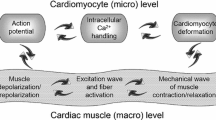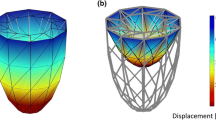Abstract
A strand of cardiac muscle was modeled as a small bundle of individual fibers surrounded by a large volume conductor. The bundle is a uniform assembly of small identical cylindrical fibers, arranged as a series of concentric layers, and its behavior is examined in the presence (coupled bundle) or absence (uncoupled bundle) of transverse resistive coupling between adjacent fibers. Individual fibers are continuous cables of excitable membrane, with circumferential segmentation into 12 equal patches to make the membrane potential changes dependent upon the local interstitial potential. The minimum spacing (d) between adjacent fibers is used to modify the interstitial microstructural organization and the intracellular volume fraction (f i). Whend is small enough (d<0.01 μm),f i remains unchanged at its maximum of about 90%, the interstitial potential is large, the transveerse interstitial resistance is high, and the proximity effect arising from the close juxtaposition of adjacent fibers is important. A surface fiber of the uncoupled bundle exhibits little sensitivity to changes in the intestitial microstructure, owing to the dominant influence of the external volume conductor, whereas the central fiber shows a large decrease in velocity, substantial waveshape modifications, and a large increase in interstitial potential asd is reduced. In the coupled bundle, all fibers adopt the same velocity during uniformo propagation owing to the strong transverse resistive coupling; whend is reduced in the range ofd<0.01 μm, the velocity and interstitial potential changes are less pronounced than in the uncoupled bundle. Whend is large enough (d>0.01 μm), the bundle behavior (coupled and uncoupled) approaches that obtained with a bidomain formulation.
Similar content being viewed by others
References
Ebihara, L., and E. A. Johnson. Fast sodium current in cardiac muscle: A quantitative description.Biophys. J. 32:779–790, 1980.
Henriquez, C. S., N. Trayanova, and R. Plonsey. Potential and current distributions is a cylindrical bundle of cardiac tissue.Biophys. J. 53:907–918, 1988.
Henriquez, C. S., and R. Plonsey. Simulation of propagation along a cylindrical bundle of cardiac tissues. I. Mathematical formulation.IEEE Trans. Biomed. Eng. 37:850–860, 1990.
Henriquez, C. S., and R. Plonsey. Simulation of propagation along a cylindrical bundle of cardiac tissues. II. Results of simulation.IEEE Trans. Biomed. Eng. 37:861–875. 1990.
Kameyama, M., and N. Tsuboi: Electrical properties of gap junctions in pairs of cardiac cells. In:Cell Interactions and Gap Junctions, vol. 2, edited by N. Sperelakis and W. C. Cole, Boca Raton, FL: CRC Press, 1989, pp. 37–48.
Kleber, A. G., and C. B. Riegger. Electrical constants of arterially perfused rabbit papillary muscle.J. Physiol. (Lond.) 385:307–324, 1986.
Knisley, S. B., T. Maruyama, and J. W. Buchanan. Intersttitial potential during propagation in bathed ventricular muscle.Biophys. J. 59:509–515, 1991.
Leon, L. J., and F. A. Roberge. A new cable model formulation based on Green's theorem.Ann. Biomed. Eng. 18:1–17, 1990.
Luo, C. H., and Y. Rudy. A model of the ventricular cardiac action potential.Circ. Res. 68:1501–1526, 1991.
Roberge, F. A., S. Wang, H. Hogues, and L. J. Leon. Propagation on a central fiber surrounded by inactive fibers in a multifibred bundle model.Ann. Biomed. Eng. 24:647–661.
Roth, B. J.. Action potential propagation in a thick strand of cardiac muscle.Circ. Res. 68:162–173, 1991.
Saffitz, J. E., H. L. Kanter, K. G. Green, T. K. Tolley, and E. C. Beyer. Tissue-specific determinants of anisotropic conduction velocity in canine atrial and ventricular myocardium.Circ. Res. 74:1065–1070, 1994.
Sommer, J. R., and B. Scherer. Geometry of cell bundle appositions in cardiac muscle: Light microscopy.Am. J. Physiol. 248:H792-H803, 1985.
Spach, J. S., W. T. Miller, III, D. B. Geselowitz, R. C. Barr, J. M. Kootsey, and E. A. Johnson. The discontinuous nature of propagation in normal canine cardiac muscle. Evidence for recurrent discontinuities of intracellular resistance that affect the membrane currents.Circ. Res. 48:39–54, 1981.
Spach, M. S., and J. M. Kootsey. The nature of electrical propagation in cardiac muscle.Am. J. Physiol. 244:H3-H22, 1983.
Suenson, M.. Interaction between ventricular cells during the early part of excitation in the ferret heart.Acta Physiol. Scand. 125:81–90, 1985.
Author information
Authors and Affiliations
Rights and permissions
About this article
Cite this article
Wang, S., Leon, L.J. & Roberge, F.A. Interactions between adjacent fibers in a cardiac muscle bundle. Ann Biomed Eng 24, 662–674 (1996). https://doi.org/10.1007/BF02684179
Received:
Revised:
Accepted:
Issue Date:
DOI: https://doi.org/10.1007/BF02684179




